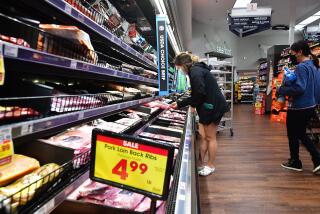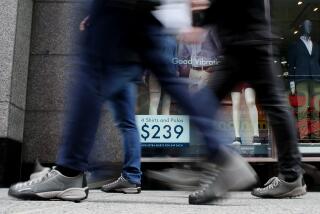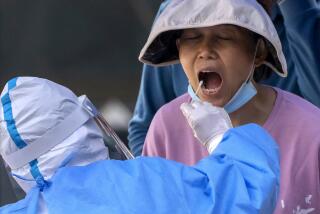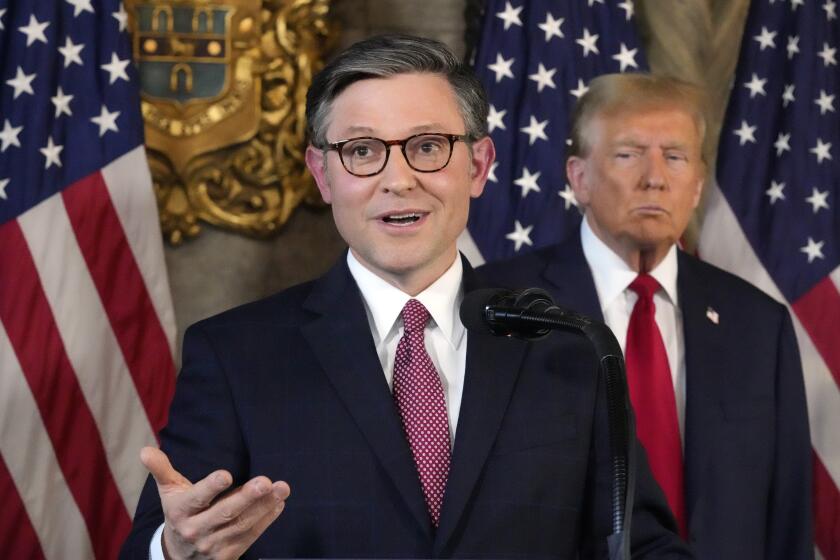Op-Ed: Coronavirus brought economic catastrophe. Here are 10 experts on how to recover
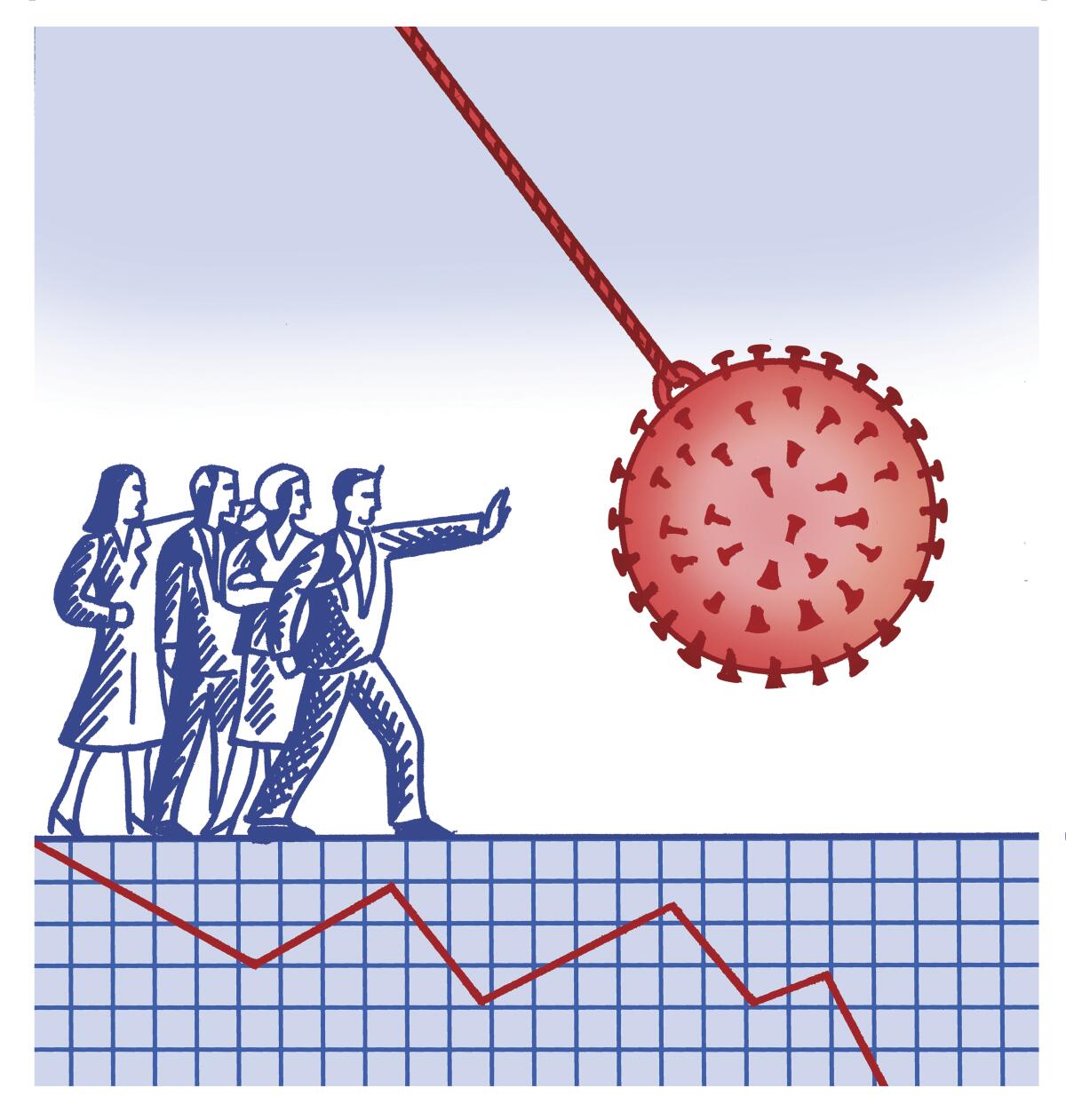
We’re seeing soaring unemployment in much of the world, highly unstable financial markets, governments amassing debt at unprecedented rates. But what is this economic crisis we find ourselves in? A recession? A depression? Something new and entirely different? We asked a range of economists to think about that question and also to propose a single policy or action government officials could embrace that would make a difference. Here are ideas from Joseph E. Stiglitz, Christina Romer, Alicia H. Munnell, Jason Furman, Anat R. Admati, James Doti, Simon Johnson, Ayse Imrohoroglu, Alex Tabarrok and Shanthi Nataraj.
A deep recession, absent better policies or luck
The U.S.’ public health failures have firmly established this nation as first in confirmed disease cases, first in deaths, first in the rise of unemployment.
Bankruptcies, the pandemic’s devastating effect on business and household balance sheets, and precautionary consumer behavior may well cause an inevitable COVID-19 downturn to morph into a deep, prolonged recession.
This is not inevitable: There are policy responses that would help immensely, or we could just get lucky, with the pandemic coming under control or the economy bouncing back faster than now appears to be the case.
As the shutdown began, we used a fire hose to try to ensure liquidity and employment: lots of money, not well-targeted and, even worse, very badly administered. Politics as usual meant that while Congress recognized problems that needed to be solved, it couldn’t fully deliver. For example, we know sick workers shouldn’t go to work, but after lobbying from big business, the legislation that passed still exempts almost half the workforce from paid sick leave.
Simply put, the government must do more to support the economy, including assistance to state and local governments, assurances that the jobless will continue to get help while the unemployment rate remains elevated, passage of paycheck relief programs that will succeed at keeping workers attached to their jobs (see the bill introduced in late May by Rep. Pramila Jayapal [D-Wash.]) and successfully getting aid to the most vulnerable, not those with the best connections to banks.
It is even possible that we could emerge post-pandemic and post-recession with a greener, more knowledge-based and more equal economy.
Joseph E. Stiglitz, co-recipient of the 2001 Nobel Prize in economics, teaches at Columbia University and is the author of “People, Power, and Profits: Progressive Capitalism for an Age of Discontent.”
Aid to states will provide the best return
When the numbers come out in July, we are likely to learn that real GDP has declined at an annual rate of close to 40% in the second quarter. Whether one calls this a recession, a depression, or a public-health-driven economic collapse really doesn’t matter; it is a tragedy.
Recent policy actions have helped to contain some of the damage and eased the struggles of unemployed workers. The Federal Reserve has quietly shored up the financial system, and Congress and the administration enacted an unprecedented $2 trillion fiscal stimulus. The expansion of unemployment insurance and the forgivable loans to small businesses that maintain payrolls were both particularly sensible policies.
But still more fiscal help is needed. The single most useful policy action now would be to provide substantial aid to state governments. States are facing severe budget shortfalls and will soon have to cut vital spending on public education, infrastructure and social services. State and local government jobs declined by almost 1 million in April, and more cuts are likely.
Transfers from the federal government (which can borrow) to states (which cannot) were done on a limited scale in the 2009 Recovery Act. Research done by the Council of Economic Advisers showed that state fiscal relief had one of the biggest bangs for the buck of any fiscal action. Moreover, such transfers allow each state to address its most pressing needs and respond to the particular challenges of local communities and industries.
With projected state budget shortfalls of more than $750 billion over the next few years, state aid of between $500 billion and $1 trillion would be appropriate. In an ideal world the size and duration of the aid would be tied to economic conditions, so that the help lasts as long as needed, but no longer. State fiscal relief is our best hope for limiting the economic damage of the pandemic and for putting the economy in a position to recover quickly when conditions allow.
Christina Romer is a professor of economics at the UC Berkeley. She was chair of the Council of Economic Advisers in 2009-2010.Pay employers to retain their workers
What should we call our current economic crisis? How about mass unemployment brought on by the coronavirus pandemic. But more important than what we call it is what we do about it. If the United States had adopted a robust program for paying employers to keep employees on the payroll even if they weren’t working, we would now be better poised for the future.
Australia and Denmark did this by creating new programs; other countries expanded existing ones. How does it work? In Denmark, for example, a Copenhagen restaurant with 10 workers can receive up to 90% of salaries — up to about $3,800 per month per employee — which the owner then uses to continue paying workers. In addition, the government compensates the owner for fixed costs, such as rent.
The advantages of this approach for the United States would be threefold. First, it would put employers in a good position to restart once the virus is subdued. Second, employees would continue to receive wages, and so wouldn’t have to apply for unemployment. And third, employees could retain their health insurance.
Recently, Congress has shown some enthusiasm for this approach. But is it too late? Two factors make it much more difficult now than it would have been in March. First, employers have already laid off many workers and would have to go through the rehiring process. Second, the $600 bump in unemployment benefits will make many low-paid workers, who are earning more now than before, reluctant to return to their job. Finally, employers have exhausted their resources so the program would have to be very generous for them to participate.
Still, I think we should plow ahead. At least we would know what to do when the next pandemic strikes.
Alicia H. Munnell is director of the Center for Retirement Research at Boston College and a professor at Boston College’s Carroll School of Management.
Pull the next policy lever: assistance to states
A catastrophic failure of economic policies created the Great Depression. That is highly unlikely now because policymakers are drawing on past lessons with a monetary and fiscal policy response that is unprecedented for its speed and its size. But we are headed for a prolonged deep recession.
More government and Federal Reserve stimulus and relief will be needed. Nonetheless, these actions can only effectively treat the demand shock associated with COVID-19; we don’t have great tools to handle the massive supply shock it is forcing across the economy. It will likely be years before per capita incomes re-attain the heights they reached before the crisis.
The biggest federal policy lever that has yet to be pulled is large-scale state and local assistance not just to cover the emergency expenses related to COVID-19 but also to plug the large holes it has blown in revenues. Absent this assistance, states will see another round of what should be avoidable layoffs, this time among teachers, firefighters and police officers.
Long lines at food banks are a wake-up call that more assistance is also needed for the most vulnerable, including increased funding for food stamps (the Supplemental Nutrition Assistance Program, or SNAP) and for healthcare. One crucial action we should take now: putting in place “triggers” that automatically continue assistance as long as the unemployment rate is above 6%.
Finally, rebuilding the economy over the longer term will require infrastructure investment, expanded training for displaced workers and eventually a plan to stabilize the debt.
Jason Furman is a professor of the practice of economic policy at Harvard University and was chairman of the Council of Economic Advisers from 2013 through 2017.
Without universal testing, recovery will be slow
Whether economists ultimately label this episode a depression or a drawn-out recession is largely irrelevant. How we fare will depend critically on the approach we take to deal with the pandemic.
Allowing the economy to sputter while providing relief that still mostly benefits investors is misguided. Instead, we must address both the public health and the economic crises by making it safer to resume activities. Until effective vaccines and therapies are available, which may be many months away, our best approach is to invest heavily in increasing the capacity for testing many more people and isolating those infected.
Opening the economy while many Americans are rightly anxious is highly problematic. Those who can afford to shelter will continue to protect themselves, while those in lower economic rungs will suffer the bulk of the hardships and the risk of infection. Recovery will be slow and halting, and the inequality of income, wealth and opportunities that was already high will only grow.
Enforcing sensible safety rules such as masks is a good start, but such measures will still restrict activities and be insufficient to ensure confidence. Imagine, however, as economist Paul Romer has suggested, that we invest in sufficient capacity so all of us, without regard to symptoms, are given accurate tests regularly (say, every two weeks) and we enable and even mandate isolation for those infected to prevent further spread. Methods like group testing (mixing several samples for a single test to see if the group tests negative, as the U.S Army did to battle syphilis during World War II) could help while testing supplies remain limited.
This approach will allow us to resume a fuller range of economic activities sooner and more safely. Even better, by protecting rich and poor alike, wide availability of testing and isolation would also begin the overdue process of building a more equitable and inclusive economy.
Anat R. Admati is a professor of finance and economics at the Stanford Graduate School of Business and the co-author of “The Bankers’ New Clothes: What’s Wrong With Banking and What to Do about It.”
A V-shaped recovery if government aid is fast
No question the COVID-19 pandemic has wrecked our economy. But this is not a repeat of the Great Depression or even the Great Recession. Although real GDP could well decline at an annualized rate of around 30-40% in the second quarter, we could see an annualized increase of 15-20% in the third quarter. While the depth of the drop this spring is unprecedented, so too will be the rapid recovery.
The economic projections done at Chapman University show a relatively short two-quarter COVID-19 recession. By contrast, the Great Recession of 2007-09 lasted seven quarters. That deep recession started out slowly but did ever increasing damage as credit markets seized up. That credit crunch led what was initially a construction-led recession to one that ultimately gripped the entire economy.
During the current recession, the economic damage is focused mainly on the leisure and hospitality sector of the economy. Unlike the Great Recession which spread to other sectors of the economy, the damage this time will be contained because of the fiscal and monetary actions that have already taken place.
Not only did we get the quick passage of the $2-trillion CARES Act, but the Federal Reserve has greased the wheels with an aggressive increase in bond purchases and lending support. Rather than the lethargic response of the Fed during the Great Recession when it took nine months before entering the scene, the Fed turned on the spigot almost immediately this year, flooding the economy with $2.5 trillion of asset purchases.
These aggressive actions have set us on the path to a relatively rapid V-shaped recovery. But for them to have a timely impact, it will be critically important for those administering the various CARES Act programs to expedite the government payments. Loans given out by banks and other financial institutions that are supported by Fed guarantees also need to be fast-tracked so that businesses aren’t prematurely forced into bankruptcy.
A fast recovery will still depend on how quickly the economy is allowed to reopen. Even more important and worrisome is whether the worst of COVID-19 is truly behind us.
James Doti is president emeritus and professor of economics at Chapman University.
Antibody tests for better public confidence
Policymakers should go all-in on ramping up antibody testing, to determine who has been exposed to COVID-19. Such tests are not yet accurate enough to determine precise immunity levels, but the work of Michael Mina, an immunologist and epidemiologist at Harvard, and others demonstrates that using such tests in the right way generates not just information about what has happened but, because of what can be inferred about underlying disease dynamics, also the information we need to understand where the disease will likely next impact various local communities. A good metaphor is that of an ocean wave — if you can see the full structure of the previous wave, you can predict a great deal about what the next wave will look like, including when and where it will crest.
These tests are cheap, and everyone should be encouraged to put a drop of blood on a special card once a month, for anonymous analysis in a public health laboratory, with the data fed seamlessly into a dashboard that can be seen by officials and everyone else.
With such data, we can better defend nursing homes, assisted living and other senior care facilities. We will be able to open schools and colleges more responsibly, because we will know much more about where the infection is currently and where it is not. We will also learn precisely what kind of workflow reorganization is helpful in controlling disease, from speeding up buses to changing who comes to work in person and when. To be clear: These antibody tests are a complement to and are not a substitute for the now-standard PCR tests for whether a person is currently infected. The continued scale-up of PCR testing capacity across the country must also continue.
The crisis we face is obviously economic — we remain now in a pure survival phase. The recovery will be difficult because, despite the Trump administration’s bravado, the confidence of many people is shattered. Rebuilding the economy requires rebuilding our confidence in public health. For this we need a type and scale of data that only antibody testing can provide.
Simon Johnson is a professor of economics at the MIT Sloan School of Management.Incentivize older people to stay home
What we are going through now acts like and looks like a recession based on the National Bureau of Economic Research definition. However, recessions usually occur because of such things as shocks to productivity or demand or problems with monetary policy. That’s not the case this time. There were no shocks to the productive capacity of our firms or to consumer confidence. We were simply told to stay home to fight the spread of a very deadly virus, and almost immediately, the economy exploded.
That is why I would label this a “synthetic” recession. It happened due to decisions made about a virus, not about the economy. Nevertheless, it could lead to a “real” recession if this shelter-in-place period lasts long enough to cause deeper wage losses, increased bankruptcies and more foreclosures.
That makes reopening the U.S. economy crucial, though it poses major challenges. COVID-19 is especially devastating for the elderly and those with preexisting health conditions. In addition to CDC recommendations about social distancing and public health strategies for all, I believe that as we reopen, we should keep a targeted lockdown policy in place for at-risk groups. If older people and others at high risk could be incentivized to stay at home, a second wave of severe illness during the reopening could be mitigated with less economic fallout, as a colleague and I recently proposed.
Currently, the Families First Coronavirus Response Act only applies to those who are sick or have sick family members. What we need is a policy designed to help the elderly and those with preexisting health conditions remain sheltered in place as the economy resumes.
Ayse Imrohoroglu is a professor of finance and business economics at USC’s Marshall School of Business.
Spend billions more on vaccines and testing
If an invader rained missiles down on cities across the United States killing thousands of people, we would fight back. Yet despite spending trillions on unemployment insurance and relief to deal with the economic consequences of COVID-19, we have spent comparatively little fighting the virus directly.
Testing capacity has slowly increased, but where is the national program to create a dozen labs each running 200,000 tests a day? It’s technologically feasible but months into the crisis, we have only just begun to spend serious money on testing.
We haven’t even fixed billing procedures so we can use the testing capacity that already exists. That’s right, labs that could be running tests are idle because of billing procedures. And while some parts of our government are slow, the Food and Drug Administration seems intent on reducing America’s ability to fight the virus by demanding business-as-usual paperwork.
Operation Warp Speed is one of the few bright spots. Potential vaccines often fail and so firms will typically not build manufacturing capacity, let alone produce doses until after a vaccine has been approved. But if we follow the usual procedure, getting shots in arms could be delayed by months or even years.
Under Operation Warp Speed, the government is paying for capacity to be built now so that the instant one of 14 vaccine candidates is proven safe and effective, production will be ready to go. That’s exactly what Nobel-prize winning economist Michael Kremer, Susan Athey, Chris Snyder and I have recommended. It might seem expensive to invest in capacity for a vaccine that is never approved, but it’s even more expensive to delay a vaccine that could end the pandemic.
Relief payments can go on forever, but money spent on testing and vaccines has the potential to more than pay for itself. It’s time to fight back.
Alex Tabarrok is a professor of economics at George Mason University and a member of the Accelerating Health Technologies With Incentive Design team.
The wealth gap widens
Whether history considers the current downturn a recession or a depression, it is clear that it will reinforce the growing inequality in our country.
Low-income workers are more likely to have lost their jobs in the pandemic and less likely to have savings to see them through. While the CARES Act increases and extends the reach of unemployment benefits, millions of workers have been unable to file for benefits, have been denied benefits, or are still waiting to receive them. And the additional benefits are scheduled to expire at the end of July — even though the Congressional Budget Office projects that unemployment will remain above 10% through 2021.
Since higher-earning Americans are more likely to own stocks, the widening gulf between a rebounding stock market and faltering business performance will only increase the wealth gap.
Running a small business — a traditional path to prosperity — has also become more perilous. Prior to the pandemic, five of 10 small businesses had a cash buffer of less than a month. Many have been unable to access Paycheck Protection Program loans; those who have received loans often aren’t sure how they are allowed to spend the money and whether it will see them through — foreshadowing a wave of bankruptcies in the near future.
Navigating this economic crisis without substantially increasing inequality would require an unwavering commitment to support displaced workers and small business owners. Once the crisis has passed, the structure of the economy, and the types of jobs available, will be different. Just as important, then — when health and economic conditions allow — would be additional investment in retraining workers who cannot return to their old jobs, and helping business owners restructure and restart their businesses.
Shanthi Nataraj is the director of the Labor and Workforce Development Program at the nonprofit, nonpartisan Rand Corp.
More to Read
A cure for the common opinion
Get thought-provoking perspectives with our weekly newsletter.
You may occasionally receive promotional content from the Los Angeles Times.
